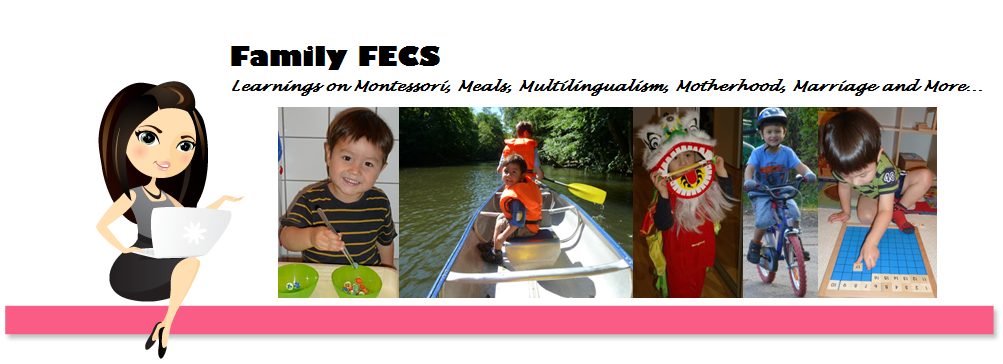Clockwise from left: Prepare the vegetables and fruit, Washed and peeled vegetables and fruit, juicer and the final result :-)
Ingredients:
- 1 apple (red colour)
- 1 orange (orange colour)
- 1 carrot (orange colour)
- 1 beetroot (purple colour)
- A handful of spinach (green colour)
- 1 inch of ginger (yellow colour)
- A handful of frozen or fresh blueberries (blue colour) (optional)
Directions:
1. Prepare all the vegetables and fruit.
2. Peel the orange and beetroot.
3. Juice them in a juicer and drink it immediately.
Tips:
1. If you line the fruit pulp holder with a plastibag before using the juicer, it will be easier to clean the juicer after use.
2. Don't throw away the fruit pulp. It can be used in cakes, vegetable lasagne, muffins, bread, etc. boil into vegetable stock for soup.
Nutritional Value:
Red fruits and vegetables are colored by natural plant pigments called "lycopene" or "anthocyanins." Lycopene in tomatoes, watermelon and pink grapefruit, for example, may help reduce risk of several types of cancer, especially prostate cancer. Lycopene in foods containing cooked tomatoes, such as spaghetti sauce, and a small amount of fat are absorbed better than lycopene from raw tomatoes.
Anthocyanins in strawberries, raspberries, red grapes and other fruits and vegetables act as powerful antioxidants that protect cells from damage. Antioxidants are linked with keeping our hearts healthy, too.
Orange/yellow fruits and vegetables are usually colored by natural plant pigments called "carotenoids." Beta-carotene in sweet potatoes, pumpkins and carrots is converted to vitamin A, which helps maintain healthy mucous membranes and healthy eyes. Scientists have also reported that carotenoid-rich foods can help reduce risk of cancer, heart disease and can improve immune system function.
Citrus fruits like oranges are not a good source of vitamin A. They are an excellent source of vitamin C and folate, a B vitamin that helps reduce risk of birth defects.
Green fruits and vegetables are colored by natural plant pigment called "chlorophyll." Some members of the green group, including spinach and other dark leafy greens, green peppers, peas, cucumber and celery, contain lutein. Lutein works with another chemical, zeaxanthin, found in corn, red peppers, oranges, grapes and egg yolks to help keep eyes healthy. Together, these chemicals may help reduce risk of cataracts and age-related macular degeneration, which can lead to blindness if untreated.
The "indoles" in broccoli, cauliflower, cabbage and other cruciferous vegetables may help protect against some types of cancer. Leafy greens such as spinach and broccoli are excellent sources of folate, a B vitamin that helps reduce risk of birth defects.
Blue/purple fruits and vegetables are colored by natural plant pigments called "anthocyanins." Anthocyanins in blueberries, grapes and raisins act as powerful antioxidants that protect cells from damage. They may help reduce risk of cancer, stroke and heart disease. Other studies have shown that eating more blueberries is linked with improved memory function and healthy aging.
Beets are also an excellent source of folate and a very good source of manganese, potassium, and copper. They are also a good source of dietary fiber, magnesium, phosphorus, vitamin C, iron, and vitamin B6.
-------------------------------------------------------------------------------------------------------------
Additional Information:
This is my favourite fruit juice. It is very nutritious, as it contains both vegetables - the spinach and carrot - and fruits. It is less appetizing to drink spinach juice alone. In this concortion, the apple and the orange help to sweeten the spinach, as well as provide the added vitamin C. An apple a day keeps the doctor away, and this concortion helps our family to achieve that easily. The carrot provides vitamin A to our body. The Danes like to jazz up their fruit juice with ginger, and it is actually very delicious with ginger. The ginger also helps to keep the body warm during winter (while at least, that's the Chinese belief). The beetroot is full of antioxidant.
It is amazing just how sweet just 1 apple and 1 orange can add to the concortion. Thus, it would be a hit with toddlers too - tastes just like pure soda to them :-)
Notice I am practising "feeding the rainbow" - yellow colour from ginger, orange colour from carrot and orange, red from apple, purple from beetroot, blue from blueberries and green from spinach. Ok, although the end result looks red, thanks to the beetroot!
Different coloured fruit/vegetable contains different nutrients. Thus, we should all try think of the rainbow and eat a variety of the different coloured vegetables and fruits, in order to get a variety of vitamins, minerals and phytonutrients.
If your child is sick and does not have appetite for solid food, not to worry, try to give him this vitamin bomb instead :-)
References:
http://www.ag.ndsu.edu/pubs/yf/foods/fn595w.htm
http://www.whfoods.com/genpage.php?tname=foodspice&dbid=49
http://www.bbcgoodfood.com/howto/guide/ingredient-focus-beetroot
| 8 October 2014 |
| Bread buns made from the beetroot Rainbow fruit juice pulp |



No comments:
Post a Comment